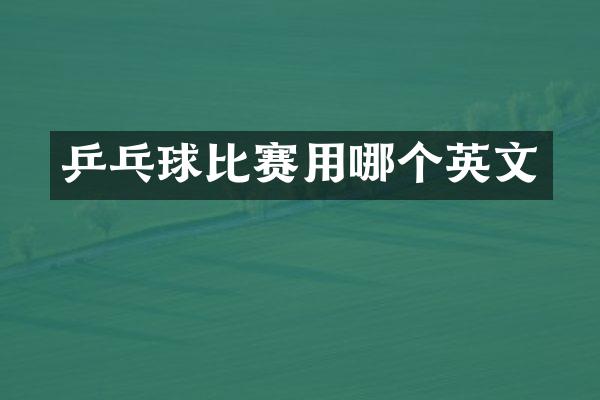Certainly! Here's an over 800-word essay on the English terminology used in table tennis (also known as ping-pong) competitions:

Table tennis, or ping-pong as it is commonly called, is a popular indoor sport played all around the world. While the game itself has its origins in late 19th century England, the sport has developed its own unique vocabulary, with many of the key terms and expressions used in table tennis coming from the English language.
The primary playing area for a table tennis match is, unsurprisingly, called a table. The standard dimensions of a regulation table tennis table are 2.74 meters (9 feet) long and 1.525 meters (5 feet) wide, with a height of 76 centimeters (2.5 feet). The table is divided into two equal halves by a net that runs across the center, standing 15.25 centimeters (6 inches) high.
Players use specialized paddles, also known as bats or rackets, to hit the lightweight, hollow celluloid ball back and forth across the net. The paddle, which must be black on one side and red on the other, is typically made of a thin layer of plywood or composite material, with a rubber surface glued on. Players can choose from a wide variety of paddle styles and technologies to suit their playing style and preferences.
In a standard table tennis match, players stand on opposite sides of the table and take turns hitting the ball, trying to win points by forcing their opponent to miss the ball or hit it out of bounds. The game is played in a best-of-three or best-of-five format, with each individual game, known as a set, played to 11 points. A player must win a set by a margin of at least two points to claim the victory.
Points are scored when a player is unable to return the ball over the net and onto the opponent's side of the table. This is known as a fault, and the player who committed the fault loses the point. Common faults include the ball not clearing the net, the ball bouncing twice on the same side of the table, or the player failing to hit the ball before it bounces twice.
Players must also be careful not to touch the table with any part of their body during a rally, as this would also result in a fault. Similarly, if a player's paddle or any part of their arm crosses over the imaginary extension of the net, it is considered a fault.
Another important rule in table tennis is the service. To start a point, the server must toss the ball upward at least 16 centimeters (6.3 inches) before striking it and then serving it diagonally across the net to the receiver's side of the table. The receiver must then return the serve before it bounces twice on their side. If the server fails to execute a proper serve, it is called a fault, and the receiver wins the point.
Throughout a table tennis match, players will employ a variety of shots and techniques to try and outmaneuver their opponent. Some common shots include the forehand drive, a powerful, topspin-heavy stroke hit with the player's dominant hand; the backhand push, a defensive, backspin-inducing shot played with the non-dominant hand; and the smash, a hard, overhead strike used to quickly end a rally.
Players may also use specialized spins and rotations to add complexity and unpredictability to their shots. These include topspin, which causes the ball to dive downward upon bouncing; backspin, which makes the ball float upward; and sidespin, which causes the ball to curve to the left or right.
In addition to the individual shots, table tennis players must also master various gameplay strategies and tactics. For example, the loop shot is a looping, topspin-heavy stroke used to attack high-bouncing balls, while the chop shot is a defensive, backspin-heavy stroke used to neutralize an opponent's attack.
Players may also employ different styles of play, such as the aggressive, offensive style that focuses on powerful, attacking shots; the defensive style that emphasizes consistent returns and forcing errors; or the all-around style that combines both offensive and defensive elements.
Throughout a table tennis match, players and coaches will also use a variety of specialized terms to communicate with each other. These include expressions like "deuce," indicating a tied score; "advantage," signifying that a player is one point away from winning the set; and "let," which is called when a serve touches the net but still lands on the proper side of the table.
Other common table tennis terms include "rally," referring to a sequence of returned shots; "spin," describing the rotation imparted on the ball; and "grip," the way a player holds their paddle. Players may also use colorful slang terms, such as "banana flip" for a shot with extreme sidespin, or "helicopter" for a shot with excessive topspin.
Overall, the rich vocabulary of table tennis, with its origins firmly rooted in the English language, reflects the sport's global popularity and the nuances of the game itself. From the basic equipment and playing area to the advanced techniques and strategies, the terminology of table tennis provides a window into the dynamic and fast-paced world of this captivating indoor sport.
查看详情
查看详情

